INFOJET
ProWeather 3
Dual METAR/TAF Search + NWS AvnWthr Flight Category(VFR,MVFR,IFR,LIFR):
RELOAD/REFRESH OBSERVATIONS
FLT CGYs
CGY/CIG/qual/VSBY
VFR/3000 ft AGL or more(CIG)/and/5 mi or more(VSBY)
MVFR/1000 to 3000 ft AGL(CIG)/and_or/3 to 5 mi (VSBY)
IFR/500 to blw 1000 ft AGL/and_or/1 mi to 3 mi (VSBY)
LIFR/blw 500 ft AGL/and_or/less than 1 mi (VSBY)
FAASafety.gov reference publication for Flight Categories
(NOTE-- The only Official reference I could find that defines these Flight Categories is in the AIM on page(s) 7-1-14 and 7-1-15 in the Meteorology section under 7−1−6. Categorical Outlooks)
7−1−6. Categorical Outlooks
a. Categorical outlook terms, describing general
ceiling and visibility conditions for advanced
planning purposes are used only in area forecasts and
are defined as follows:
1. LIFR (Low IFR). Ceiling less than 500 feet
and/or visibility less than 1 mile.
2. IFR. Ceiling 500 to less than 1,000 feet
and/or visibility 1 to less than 3 miles.
3. MVFR (Marginal VFR). Ceiling 1,000 to
3,000 feet and/or visibility 3 to 5 miles inclusive.
4. VFR. Ceiling greater than 3,000 feet and
visibility greater than 5 miles; includes sky clear.
b. The cause of LIFR, IFR, or MVFR is indicated
by either ceiling or visibility restrictions or both. The
contraction “CIG” and/or weather and obstruction to
vision symbols are used. If winds or gusts of 25 knots
or greater are forecast for the outlook period, the word
“WIND” is also included for all categories including
VFR.
EXAMPLE−
1. LIFR CIG−low IFR due to low ceiling.
2. IFR FG−IFR due to visibility restricted by fog.
3. MVFR CIG HZ FU−marginal VFR due to both ceiling
and visibility restricted by haze and smoke.
4. IFR CIG RA WIND−IFR due to both low ceiling and
visibility restricted by rain; wind expected to be 25 knots or
greater.
(AIM pgs 7-1-14,7-1-15, Meteorology)
§91.113 Right-of-way rules: Except water operations.
(a) Inapplicability. This section does not apply to the operation of an aircraft on water.
(b) General. When weather conditions permit, regardless of whether an operation is conducted under instrument flight rules or visual flight rules, vigilance shall be maintained by each person operating an aircraft so as to see and avoid other aircraft. When a rule of this section gives another aircraft the right-of-way, the pilot shall give way to that aircraft and may not pass over, under, or ahead of it unless well clear.
(c) In distress. An aircraft in distress has the right-of-way over all other air traffic.
(d) Converging. When aircraft of the same category are converging at approximately the same altitude (except head-on, or nearly so), the aircraft to the other's right has the right-of-way. If the aircraft are of different categories—
(1) A balloon has the right-of-way over any other category of aircraft;
(2) A glider has the right-of-way over an airship, powered parachute, weight-shift-control aircraft, airplane, or rotorcraft.
(3) An airship has the right-of-way over a powered parachute, weight-shift-control aircraft, airplane, or rotorcraft.
However, an aircraft towing or refueling other aircraft has the right-of-way over all other engine-driven aircraft.
(e) Approaching head-on. When aircraft are approaching each other head-on, or nearly so, each pilot of each aircraft shall alter course to the right.
(f) Overtaking. Each aircraft that is being overtaken has the right-of-way and each pilot of an overtaking aircraft shall alter course to the right to pass well clear.
(g) Landing. Aircraft, while on final approach to land or while landing, have the right-of-way over other aircraft in flight or operating on the surface, except that they shall not take advantage of this rule to force an aircraft off the runway surface which has already landed and is attempting to make way for an aircraft on final approach. When two or more aircraft are approaching an airport for the purpose of landing, the aircraft at the lower altitude has the right-of-way, but it shall not take advantage of this rule to cut in front of another which is on final approach to land or to overtake that aircraft.
[Doc. No. 18334, 54 FR 34294, Aug. 18, 1989, as amended by Amdt. 91-282, 69 FR 44880, July 27, 2004]
§91.115 Right-of-way rules: Water operations.
(a) General. Each person operating an aircraft on the water shall, insofar as possible, keep clear of all vessels and avoid impeding their navigation, and shall give way to any vessel or other aircraft that is given the right-of-way by any rule of this section.
(b) Crossing. When aircraft, or an aircraft and a vessel, are on crossing courses, the aircraft or vessel to the other's right has the right-of-way.
(c) Approaching head-on. When aircraft, or an aircraft and a vessel, are approaching head-on, or nearly so, each shall alter its course to the right to keep well clear.
(d) Overtaking. Each aircraft or vessel that is being overtaken has the right-of-way, and the one overtaking shall alter course to keep well clear.
(e) Special circumstances. When aircraft, or an aircraft and a vessel, approach so as to involve risk of collision, each aircraft or vessel shall proceed with careful regard to existing circumstances, including the limitations of the respective craft.
§91.117 Aircraft speed.
(a) Unless otherwise authorized by the Administrator, no person may operate an aircraft below 10,000 feet MSL at an indicated airspeed of more than 250 knots (288 m.p.h.).
(b) Unless otherwise authorized or required by ATC, no person may operate an aircraft at or below 2,500 feet above the surface within 4 nautical miles of the primary airport of a Class C or Class D airspace area at an indicated airspeed of more than 200 knots (230 mph.). This paragraph (b) does not apply to any operations within a Class B airspace area. Such operations shall comply with paragraph (a) of this section.
(c) No person may operate an aircraft in the airspace underlying a Class B airspace area designated for an airport or in a VFR corridor designated through such a Class B airspace area, at an indicated airspeed of more than 200 knots (230 mph).
(d) If the minimum safe airspeed for any particular operation is greater than the maximum speed prescribed in this section, the aircraft may be operated at that minimum speed.
[Doc. No. 18334, 54 FR 34292, Aug. 18, 1989, as amended by Amdt. 91-219, 55 FR 34708, Aug. 24, 1990; Amdt. 91-227, 56 FR 65657, Dec. 17, 1991; Amdt. 91-233, 58 FR 43554, Aug. 17, 1993]
§91.119 Minimum safe altitudes: General.
Except when necessary for takeoff or landing, no person may operate an aircraft below the following altitudes:
(a) Anywhere. An altitude allowing, if a power unit fails, an emergency landing without undue hazard to persons or property on the surface.
(b) Over congested areas. Over any congested area of a city, town, or settlement, or over any open air assembly of persons, an altitude of 1,000 feet above the highest obstacle within a horizontal radius of 2,000 feet of the aircraft.
(c) Over other than congested areas. An altitude of 500 feet above the surface, except over open water or sparsely populated areas. In those cases, the aircraft may not be operated closer than 500 feet to any person, vessel, vehicle, or structure.
(d) Helicopters, powered parachutes, and weight-shift-control aircraft. If the operation is conducted without hazard to persons or property on the surface—
(1) A helicopter may be operated at less than the minimums prescribed in paragraph (b) or (c) of this section, provided each person operating the helicopter complies with any routes or altitudes specifically prescribed for helicopters by the FAA; and
(2) A powered parachute or weight-shift-control aircraft may be operated at less than the minimums prescribed in paragraph (c) of this section.
[Doc. No. 18334, 54 FR 34294, Aug. 18, 1989, as amended by Amdt. 91-311, 75 FR 5223, Feb. 1, 2010]
§91.125 ATC light signals.
ATC light signals have the meaning shown in the following table:
| Color and type of signal | Meaning with respect to aircraft on the surface | Meaning with respect to aircraft in flight |
|---|
| Steady green | Cleared for takeoff | Cleared to land. |
| Flashing green | Cleared to taxi | Return for landing (to be followed by steady green at proper time). |
| Steady red | Stop | Give way to other aircraft and continue circling. |
| Flashing red | Taxi clear of runway in use | Airport unsafe—do not land. |
| Flashing white | Return to starting point on airport | Not applicable. |
| Alternating red and green | Exercise extreme caution | Exercise extreme caution. |
14 CFR §91.155 Basic VFR weather minimums (shows Flt Vsby and Dist. from clouds for Class A-G airspace)(minimum here is 1000 ft CIG and VSBY of 3 statute miles)
Sec. 91.155
Basic VFR weather minimums.
(a) Except as provided in paragraph (b) of this section and Sec. 91.157, no person may operate an aircraft under VFR when the flight visibility is less, or at a distance from clouds that is less, than that prescribed for the corresponding altitude and class of airspace in the following table:
Airspace | Flight visibility | Distance from
clouds |
| Class A ----------------------------- | Not Applicable ------------------- | Not Applicable. |
| Class B ----------------------------- | 3 statute miles -------------------- | Clear of Clouds. |
| Class C ----------------------------- | 3 statute miles -------------------- | 500 feet below.
1,000 feet above.
2,000 feet horizontal. |
| Class D ----------------------------- | 3 statute miles --------------------- | 500 feet below.
1,000 feet above.
2,000 feet horizontal. |
Class E:
Less than 10,000 feet MSL. | 3 statute miles -------------------- | 500 feet below.
1,000 feet above.
2,000 feet horizontal. |
| At or above 10,000 feet MSL. | 5 statute miles -------------------- | 1,000 feet below.
1,000 feet above.
1 statute mile horizontal. |
Class G:
1,200 feet or less above the
surface (regardless of MSL
altitude). |  |  |
Day, except as provided in
Sec. 91.155(b). | 1 statute mile ---------------------- | Clear of clouds. |
Night, except as provided in
Sec. 91.155(b). | 3 statute miles -------------------- | 500 feet below.
1,000 feet above.
2,000 feet horizontal. |
More than 1,200 feet above the
surface but less than 10,000
feet MSL |  |  |
| Day ----------------------------------- | 1 statute mile ---------------------- | 500 feet below.
1,000 feet above.
2,000 feet horizontal. |
| Night --------------------------------- | 3 statute miles -------------------- | 500 feet below.
1,000 feet above.
2,000 feet horizontal. |
More than 1,200 feet above the
surface and at or above
10,000 feet MSL. | 5 statute miles -------------------- | 1,000 feet below.
1,000 feet above.
1 statute mile horizontal. |
(b) Class G Airspace. Notwithstanding the provisions of paragraph (a) of this section, the following operations may be conducted in Class G airspace below 1,200 feet above the surface:
(1) Helicopter. A helicopter may be operated clear of clouds in an airport traffic pattern within1/2mile of the runway or helipad of intended landing if the flight visibility is not less than1/2statute mile.
(2) Airplane, powered parachute, or weight-shift-control aircraft.. If the visibility is less than 3 statute miles but not less than 1 statute mile during night hours and you are operating in an airport traffic pattern within one-half mile of the runway, you may operate an airplane, powered parachute, or weight-shift-control aircraft clear of clouds.
(c) Except as provided in Sec. 91.157, no person may operate an aircraft beneath the ceiling under VFR within the lateral boundaries of controlled airspace designated to the surface for an airport when the ceiling is less than 1,000 feet.
(d) Except as provided in Sec. 91.157 of this part, no person may take off or land an aircraft, or enter the traffic pattern of an airport, under VFR, within the lateral boundaries of the surface areas of Class B, Class C, Class D, or Class E airspace designated for an airport--
(1) Unless ground visibility at that airport is at least 3 statute miles; or
(2) If ground visibility is not reported at that airport, unless flight visibility during landing or takeoff, or while operating in the traffic pattern is at least 3 statute miles.
(e) For the purpose of this section, an aircraft operating at the base altitude of a Class E airspace area is considered to be within the airspace directly below that area.
Amdt. 91-330, Eff. 4/22/2015
SVFR/Clear of Clouds(CIG_Dist fm Clds)/and/at least 1 statute mile (VSBY)/and/ATC Clearance rcvd/(only allwd during day for VFR pilots blw 10,000 ft MSL abv twrd apt(FAR 91.157))
Sec. 91.157
Special VFR weather minimums.
(a) Except as provided in appendix D, section 3, of this part, special VFR operations may be conducted under the weather minimums and requirements of this section, instead of those contained in Sec. 91.155, below 10,000 feet MSL within the airspace contained by the upward extension of the lateral boundaries of the controlled airspace designated to the surface for an airport.
(b) Special VFR operations may only be conducted--
(1) With an ATC clearance;
(2) Clear of clouds;
(3) Except for helicopters, when flight visibility is at least 1 statute mile; and
(4) Except for helicopters, between sunrise and sunset (or in Alaska, when the sun is 6 degrees or more below the horizon) unless--
(c) No person may take off or land an aircraft (other than a helicopter) under special VFR--
(1) Unless ground visibility is at least 1 statute mile; or
[(2) If ground visibility is not reported, unless flight visibility is at least 1 statute mile. For the purposes of this paragraph, the term flight visibility includes the visibility from the cockpit of an aircraft in takeoff position if:
(i) The flight is conducted under this part 91; and
(ii) The airport at which the aircraft is located is a satellite airport that does not have weather reporting capabilities.
(d) The determination of visibility by a pilot in accordance with paragraph (c)(2) of this section is not an official weather report or an official ground visibility report.]
Amdt. 91-262, Eff. 5/23/2000
Can ATC issue/authorize a Special VFR departure out of Sacramento Executive (KSAC) under the below conditions?
(Requesting a departure to the West?)

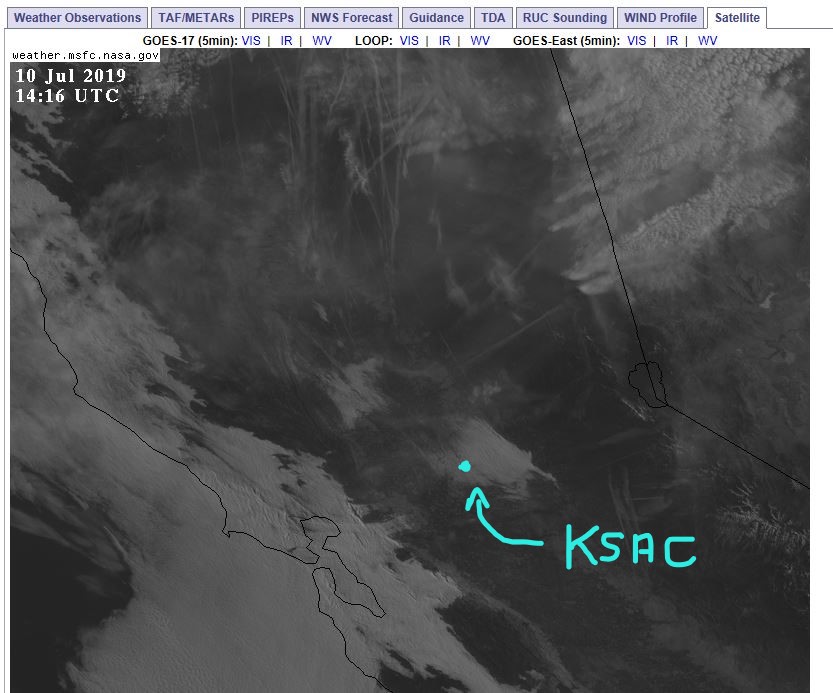
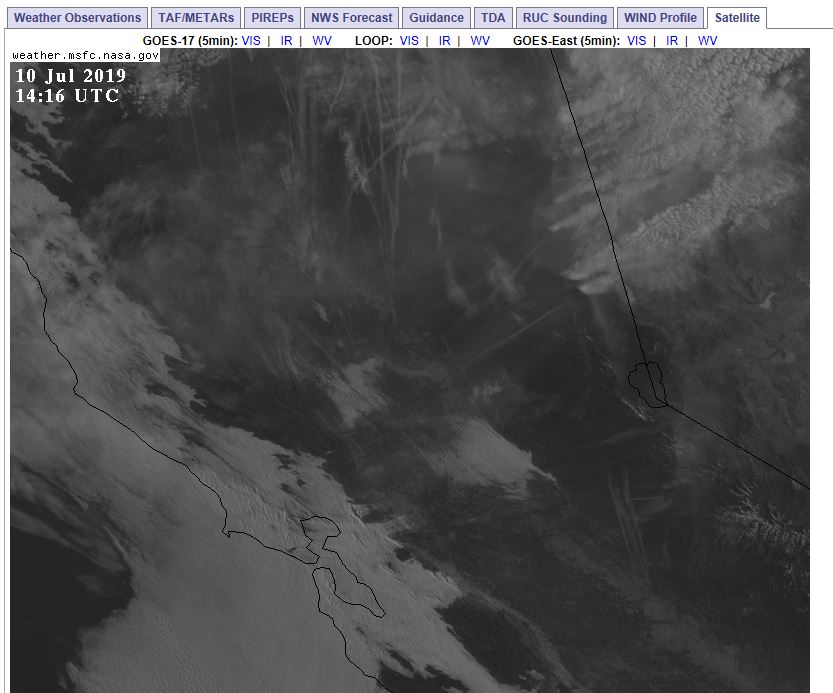
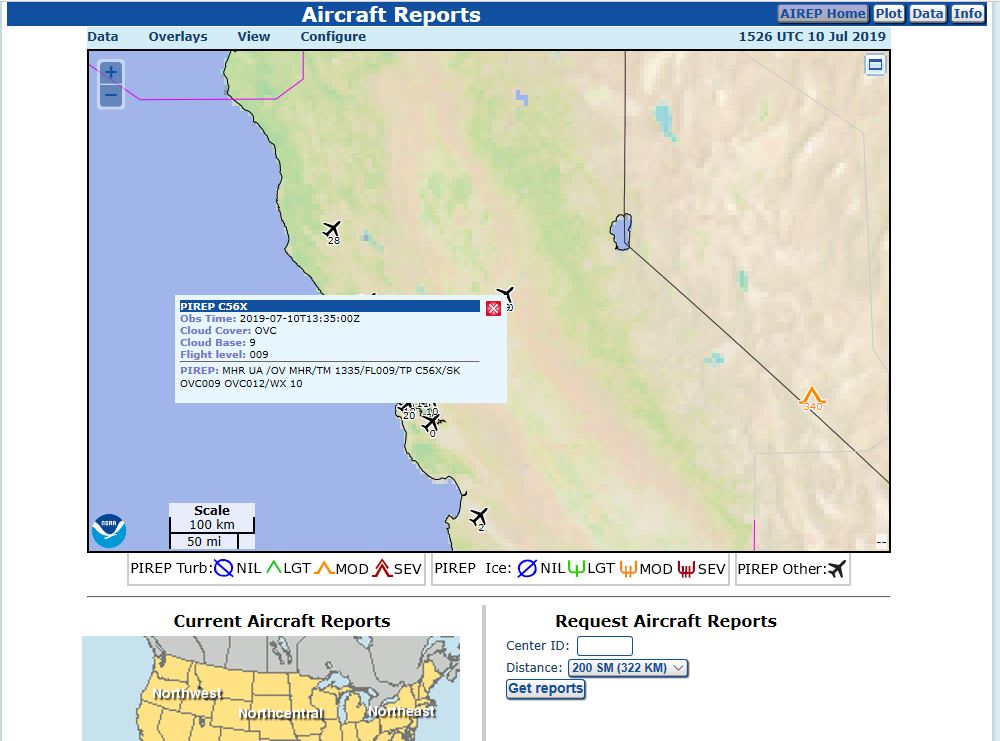

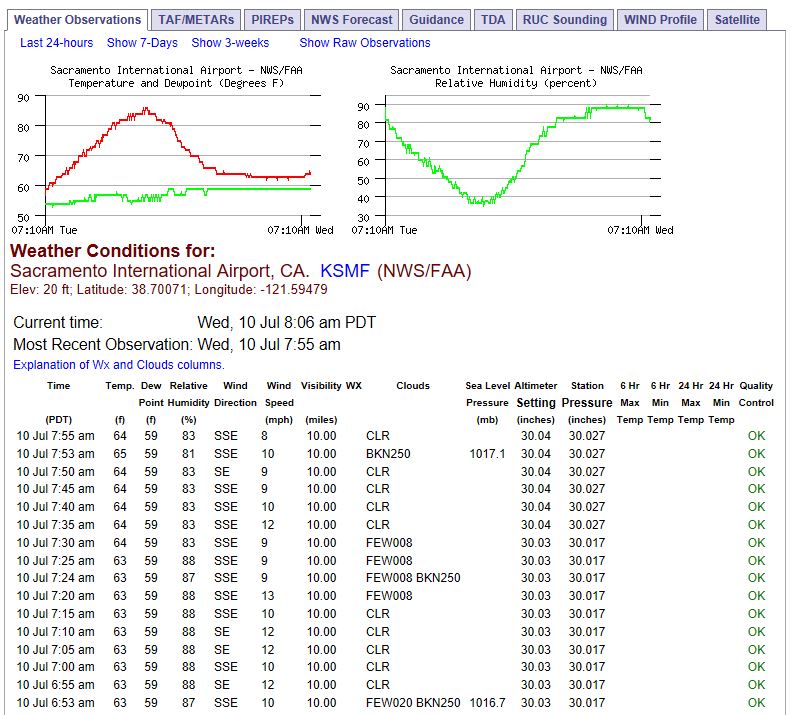
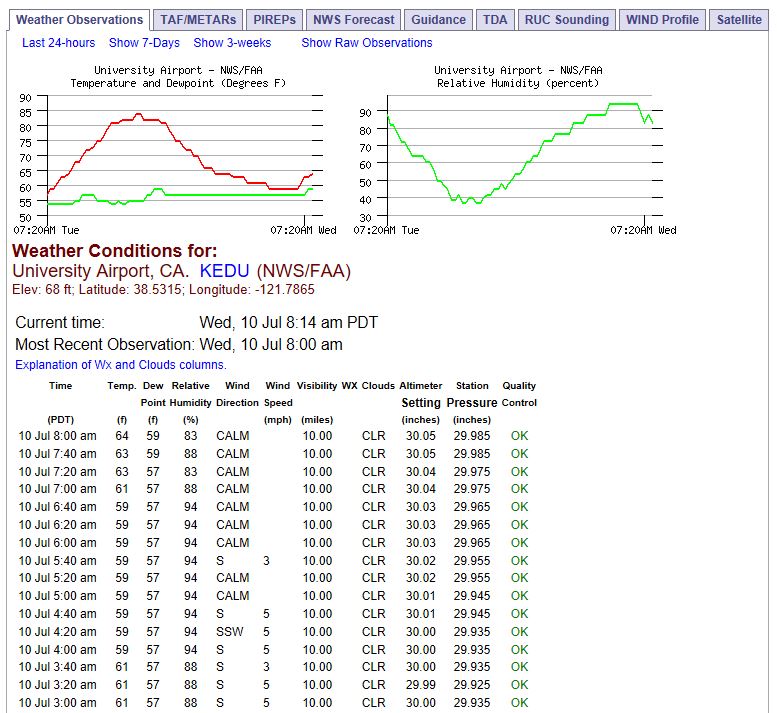
Sec. 91.159
VFR cruising altitude or flight level.
Except while holding in a holding pattern of 2 minutes or less, or while turning, each person operating an aircraft under VFR in level cruising flight more than 3,000 feet above the surface shall maintain the appropriate altitude or flight level prescribed below, unless otherwise authorized by ATC:
(a) When operating below 18,000 feet MSL and--
(1) On a magnetic course of zero degrees through 179 degrees, any odd thousand foot MSL altitude +500 feet (such as 3,500, 5,500, or 7,500); or
(2) On a magnetic course of 180 degrees through 359 degrees, any even thousand foot MSL altitude +500 feet (such as 4,500, 6,500, or 8,500).
[(b) When operating above 18,000 feet MSL, maintain the altitude or flight level assigned by ATC.]
[(c) Removed.]
Title 14 → Chapter I → Subchapter F → Part 91 → Subpart C → §91.211
Browse Previous | Browse Next
Title 14: Aeronautics and Space
PART 91—GENERAL OPERATING AND FLIGHT RULES
Subpart C—Equipment, Instrument, and Certificate Requirements
§91.211 Supplemental oxygen.
(a) General. No person may operate a civil aircraft of U.S. registry—
(1) At cabin pressure altitudes above 12,500 feet (MSL) up to and including 14,000 feet (MSL) unless the required minimum flight crew is provided with and uses supplemental oxygen for that part of the flight at those altitudes that is of more than 30 minutes duration;
(2) At cabin pressure altitudes above 14,000 feet (MSL) unless the required minimum flight crew is provided with and uses supplemental oxygen during the entire flight time at those altitudes; and
(3) At cabin pressure altitudes above 15,000 feet (MSL) unless each occupant of the aircraft is provided with supplemental oxygen.
(b) Pressurized cabin aircraft. (1) No person may operate a civil aircraft of U.S. registry with a pressurized cabin—
(i) At flight altitudes above flight level 250 unless at least a 10-minute supply of supplemental oxygen, in addition to any oxygen required to satisfy paragraph (a) of this section, is available for each occupant of the aircraft for use in the event that a descent is necessitated by loss of cabin pressurization; and
(ii) At flight altitudes above flight level 350 unless one pilot at the controls of the airplane is wearing and using an oxygen mask that is secured and sealed and that either supplies oxygen at all times or automatically supplies oxygen whenever the cabin pressure altitude of the airplane exceeds 14,000 feet (MSL), except that the one pilot need not wear and use an oxygen mask while at or below flight level 410 if there are two pilots at the controls and each pilot has a quick-donning type of oxygen mask that can be placed on the face with one hand from the ready position within 5 seconds, supplying oxygen and properly secured and sealed.
(2) Notwithstanding paragraph (b)(1)(ii) of this section, if for any reason at any time it is necessary for one pilot to leave the controls of the aircraft when operating at flight altitudes above flight level 350, the remaining pilot at the controls shall put on and use an oxygen mask until the other pilot has returned to that crewmember's station.
Need assistance?
CSV FLT LOG entry (you dtrmn csv structure)
INFOJET






